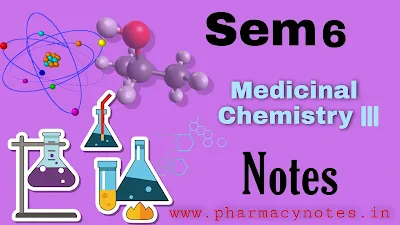Handwritten Notes
Semester 6
BP601T. MEDICINAL CHEMISTRY – III (Theory)
Study of the development of the following classes of drugs, Classification, mechanism of action, uses of drugs mentioned in the course, Structure-activity relationship of selective class of drugs as specified in the course, and synthesis of drugs superscripted by (*)
UNIT–I
AntibioticsHistorical background, Nomenclature, Stereochemistry, Structure-activity relationship, Chemical degradation classification, and important products of the following classes.
-Lactam antibiotics: Penicillin, Cephalosporins, -Lactamase inhibitors, Monobactams
Aminoglycosides: Streptomycin, Neomycin, Kanamycin
Tetracyclines: Tetracycline,Oxytetracycline, Chlortetracycline, Minocycline, Doxycycline
UNIT–II
Antibiotics
Historical background, Nomenclature, Stereochemistry, Structure-activity relationship, Chemical degradation classification, and important products of the following classes.
Macrolide: Erythromycin Clarithromycin, Azithromycin.
Miscellaneous: Chloramphenicol*, Clindamycin.
Prodrugs: Basic concepts and application of prodrugs design.
Antimalarials: Etiology of malaria.
Quinolines: SAR, Quinine sulphate, Chloroquine*, Amodiaquine, Primaquine phosphate, Pamaquine*, Quinacrine hydrochloride, Mefloquine.
Biguanides and dihydro triazines: Cycloguanil pamoate, Proguanil.
Miscellaneous: Pyrimethamine, Artesunate, Artemether, Atovaquone.
UNIT–III
Anti-tubercular Agents
Synthetic antitubercular agents: Isoniazid*, Ethionamide, Ethambutol, Pyrazinamide, Para aminosalicylic acid.*
Antitubercular antibiotics: Rifampicin, Rifabutin, Cycloserine Streptomycine, Capreomycin sulphate.
Urinary tract anti-infective agents
Quinolones: SAR of quinolones, Nalidixic Acid,Norfloxacin, Enoxacin, Ciprofloxacin*, Ofloxacin, Lomefloxacin, Sparfloxacin, Gatifloxacin, Moxifloxacin
Miscellaneous: Furazolidine, Nitrofurantoin*, Methanamine.
Antiviral agents:
Amantadine hydrochloride, Rimantadine hydrochloride, Idoxuridine trifluoride, Acyclovir*, Gancyclovir, Zidovudine, Didanosine, Zalcitabine, Lamivudine, Loviride, Delavirding, Ribavirin, Saquinavir, Indinavir, Ritonavir.
UNIT–IV
Antifungal agents:
Antifungal antibiotics: Amphotericin-B, Nystatin, Natamycin, Griseofulvin.
Synthetic Antifungal agents: Clotrimazole, Econazole, Butoconazole, Oxiconazole Tioconozole, Miconazole*, Ketoconazole, Terconazole, Itraconazole, Fluconazole, Naftifine hydrochloride, Tolnaftate*.
Anti-protozoal Agents: Metronidazole*, Tinidazole, Ornidazole, Diloxanide, Iodoquinol, Pentamidine Isethionate, Atovaquone, Eflornithine.
Anthelmintics: Diethylcarbamazine citrate*, Thiabendazole, Mebendazole*, Albendazole, Niclosamide, Oxamniquine, Praziquantal, Ivermectin.
Sulphonamides and Sulfones
Historical development, chemistry, classification, and SAR of Sulfonamides: Sulphamethizole, Sulfisoxazole, Sulphamethizine, Sulfacetamide*, Sulphapyridine, Sulfamethoxaole*, Sulphadiazine, Mefenide acetate, Sulfasalazine.
Folate reductase inhibitors: Trimethoprim*, Cotrimoxazole.
Sulfones: Dapsone*.
UNIT–V
Introduction to Drug Design
Various approaches used in drug design.
Physicochemical parameters used in a quantitative structure-activity relationship (QSAR) such as partition coefficient, Hammet’s electronic parameter, Taft's steric parameter, and Hansch analysis.
Pharmacophore modeling and docking techniques.
Combinatorial Chemistry: Concept and applications of combinatorial chemistry: solid phase and solution phase synthesis.








Please do not enter any spam link in the comment box.